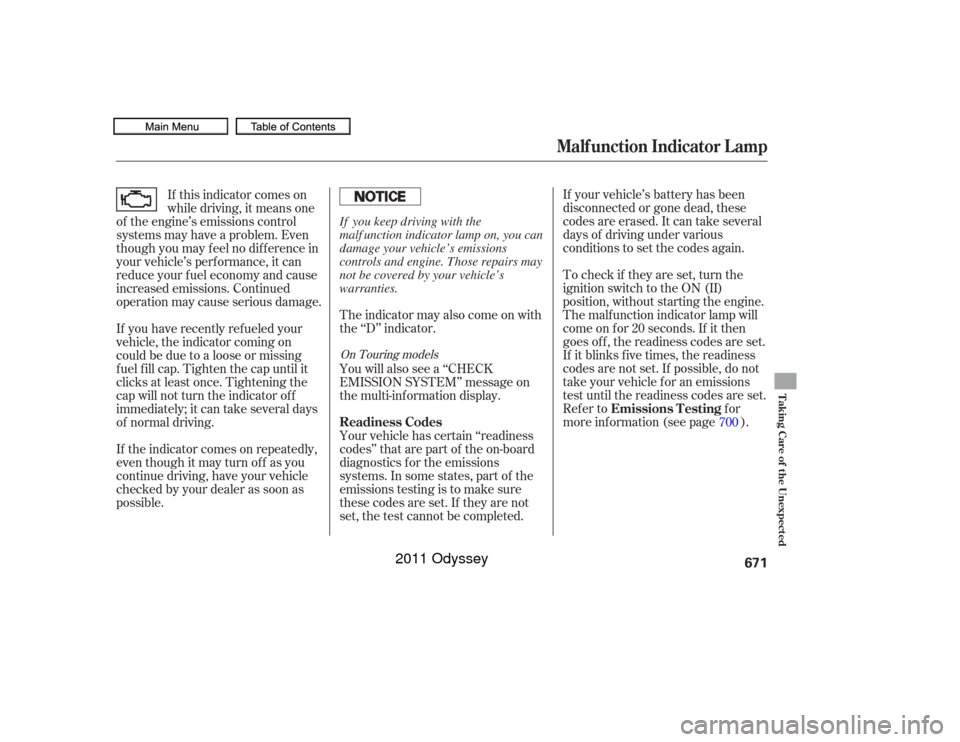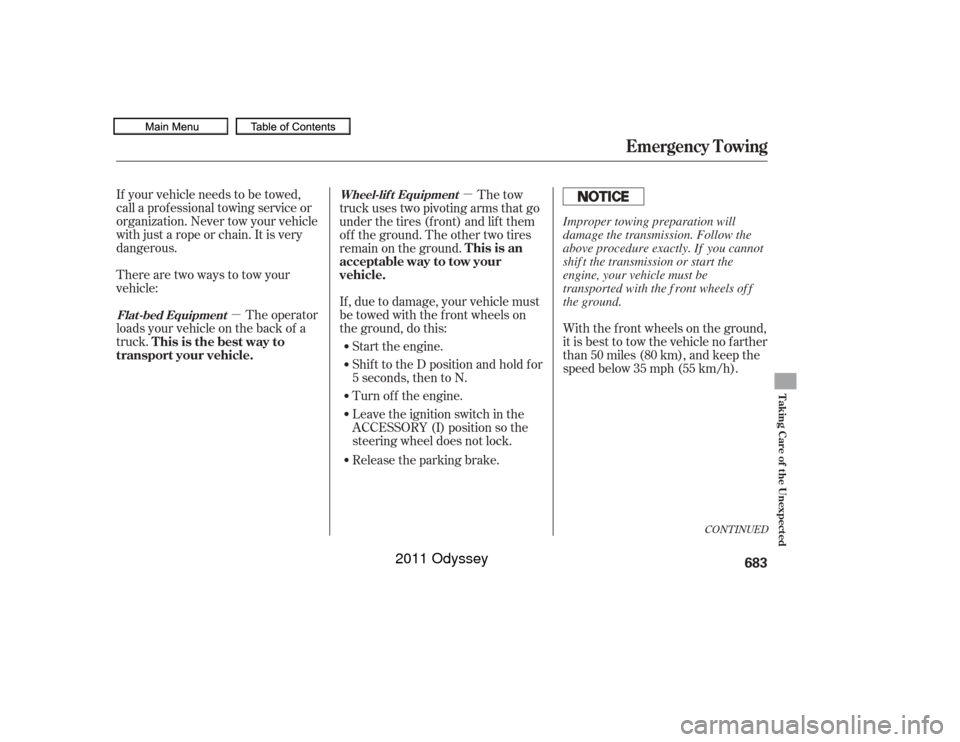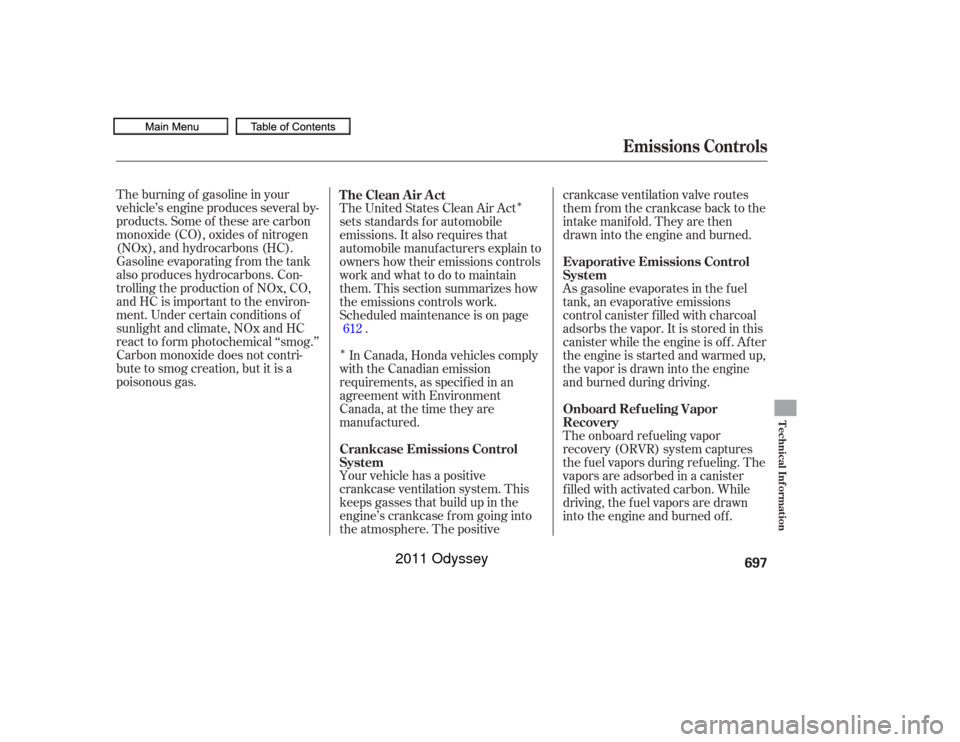Page 673 of 722
Immediately turn of f all electrical
accessories. Try not to use other
electrically operated controls such as
the power windows. Keep the engine
running; starting the engine will
discharge the battery rapidly.
Go to a service station or garage
where you can get technical
assistance.If you see a ‘‘REPLACE BATTERY’’
message on the multi-information
display (‘‘CHANGE BATT’’ message
on the inf ormation display on some
models), along with this indicator on,
you may need to replace the battery.
Have your vehicle’s battery checked
andreplacedbyyourdealer.
If the charging system
indicator comes on brightly
when the engine is running, the
battery is not being charged.
You will also see a ‘‘CHECK
CHARGE SYSTEM’’ message on the
inf ormation display.
You will also see a ‘‘CHECK
CHARGING SYSTEM’’ message on
the multi-information display.
Except Touring models
On Touring modelsCharging System Indicator670
10/07/17 11:03:50 31TK8600_675
2011 Odyssey
Page 674 of 722

If your vehicle’s battery has been
disconnected or gone dead, these
codes are erased. It can take several
days of driving under various
conditions to set the codes again.
To check if they are set, turn the
ignition switch to the ON (II)
position, without starting the engine.
The malf unction indicator lamp will
come on f or 20 seconds. If it then
goes of f , the readiness codes are set.
If it blinks f ive times, the readiness
codes are not set. If possible, do not
take your vehicle f or an emissions
test until the readiness codes are set.
Refer tofor
more information (see page ).
The indicator may also come on with
the ‘‘D’’ indicator.
If this indicator comes on
while driving, it means one
of the engine’s emissions control
systems may have a problem. Even
though you may f eel no dif f erence in
your vehicle’s perf ormance, it can
reduce your f uel economy and cause
increased emissions. Continued
operation may cause serious damage.
If you have recently ref ueled your
vehicle, the indicator coming on
could be due to a loose or missing
f uel f ill cap. Tighten the cap until it
clicks at least once. Tightening the
cap will not turn the indicator of f
immediately; it can take several days
of normal driving.
If the indicator comes on repeatedly,
even though it may turn of f as you
continue driving, have your vehicle
checked by your dealer as soon as
possible. You will also see a ‘‘CHECK
EMISSION SYSTEM’’ message on
the multi-information display.
Your vehicle has certain ‘‘readiness
codes’’ that are part of the on-board
diagnostics f or the emissions
systems. In some states, part of the
emissions testing is to make sure
these codes are set. If they are not
set, the test cannot be completed.
700
On Touring models
Malf unction Indicator L amp
Emissions T esting
Readiness Codes
Taking Care of the Unexpected
671
If you keep driving with the
malf unction indicator lamp on, you can
damage your vehicle’s emissions
controls and engine. Those repairs may
not be covered by your vehicle’s
warranties.
10/07/17 11:03:58 31TK8600_676
2011 Odyssey
Page 686 of 722

�µ�µ
If your vehicle needs to be towed,
call a prof essional towing service or
organization. Never tow your vehicle
with just a rope or chain. It is very
dangerous.
Therearetwowaystotowyour
vehicle:
With the f ront wheels on the ground,
it is best to tow the vehicle no farther
than 50 miles (80 km), and keep the
speedbelow35mph(55km/h).
The operator
loads your vehicle on the back of a
truck. The tow
truck uses two pivoting arms that go
under the tires (f ront) and lif t them
of f the ground. The other two tires
remain on the ground.
If , due to damage, your vehicle must
be towed with the f ront wheels on
the ground, do this:
Start the engine.
Shif t to the D position and hold f or
5 seconds, then to N.
Turn of f the engine.
Leave the ignition switch in the
ACCESSORY (I) position so the
steering wheel does not lock.
Release the parking brake.
CONT INUED
Flat -bed Equipment Wheel-lif t Equipment
T his is the best way to
transport your vehicle. T his is an
acceptable way to tow your
vehicle.
Emergency Towing
Taking Care of the Unexpected
683
Improper towing preparation will
damage the transmission. Follow the
above procedure exactly. If you cannot
shif t the transmission or start the
engine, your vehicle must be
transported with the f ront wheels of f
the ground.
10/07/17 11:05:23 31TK8600_688
2011 Odyssey
Page 689 of 722
Your vehicle has several identif ying
numbers in various places.
The vehicle identif ication number
(VIN) is the 17-digit number your
dealer uses to register your vehicle
f or warranty purposes. It is also
necessary f or licensing and insuring
your vehicle. The easiest place to
find the VIN is on a plate fastened to
the top of the dashboard. You can
seeitbylookingthroughthe
windshield on the driver’s side. It is
also on the certification label
attached to the driver’s doorjamb,
and is stamped on the engine
compartment bulkhead. The VIN is
also provided in bar code on the
certif ication label.Identif ication Numbers686
VEHICLE IDENTIFICATION NUMBER (VIN)CERTIFICATION LABEL
10/07/17 11:05:34 31TK8600_691
2011 Odyssey
Page 690 of 722
The engine number is stamped into
the engine block. It is on the f ront.
The transmission number is on a
label on the side of the transmission. The transmission number is on a
label on top of the transmission.Except Touring modelsTouring models
Identif ication Numbers
T echnical Inf ormation
687
ENGINE NUMBER
TRANSMISSION NUMBER TRANSMISSION NUMBER
ENGINE NUMBER
Touring models Except Touring models
10/07/17 11:05:40 31TK8600_692
2011 Odyssey
Page 691 of 722

�µ�µ
�Î
�Î
�Î
�Î
�Î
�Î
�Î
Specif ications688
Air Conditioning
Dimensions
Engine Weights Capacities
3.3 US qt (3.1
)
5.3 US qt (5.0)
4.2 US qt (4.0)
4.5 US qt (4.3)
2.64 US gal (10.0
)
1.93 US gal (7.3)
24.7 26.5 oz (700 750 g)
ND-OIL8
HFC-134a (R-134a)
21 US gal (79.5)
Refrigerant type
Charge quantity
Lubricant type
78.6 in (1,997 mm) 202.9 in (5,153 mm)
Length
Width
Height
Wheelbase
Track 118.1 in (3,000 mm)
68.1 in (1,730 mm)
68.2 in (1,732 mm)
8,477 lbs (3,845 kg)
Water cooled 4-stroke SOHC
i-VTEC · VCM2, 6-cylinder (V6), gasoline engine
3.50 x 3.66 in (89.0 x 93.0 mm) 212 cu-in (3,471 cm
)
Type
BorexStroke
Displacement
Compression ratio
Spark plugs
DILZKR7A11G
68.4 in (1,737 mm)
10.5 : 1
See the tire information label
attached to the driver’s doorjamb.
Gross vehicle weight rating
Gross combined weight
rating (GCWR) Fuel tank
Engine
coolant
Engine oil
Automatic
transmission
fluid
Windshield
washer
reservoir
4.8 US qt (4.5
)
2.6 US qt (2.5)
7.4 US qt (7.0)
8.0 US qt (7.6)
3.6 US qt (3.4)
Excluding the oil remaining in the engine 0.225 US gal (0.85
)
Including the coolant in the reserve tank and that remaining in the
engine
Reserve tank capacity:
Front
Rear
Approx.
NGK: 1:
2:
3 : Touring modelsChange
Total
Change
Including
filter
Without
filter
Total
Change
Total
U.S. Vehicles
Canada Vehicles
3
1
2
3
10/07/17 11:05:55 31TK8600_693
2011 Odyssey
Page 700 of 722

�Î
�Î
The burning of gasoline in your
vehicle’s engine produces several by-
products. Some of these are carbon
monoxide (CO), oxides of nitrogen
(NOx), and hydrocarbons (HC).
Gasoline evaporating f rom the tank
also produces hydrocarbons. Con-
trolling the production of NOx, CO,
and HC is important to the environ-
ment. Under certain conditions of
sunlight and climate, NOx and HC
react to f orm photochemical ‘‘smog.’’
Carbon monoxide does not contri-
bute to smog creation, but it is a
poisonous gas. The United States Clean Air Act
sets standards f or automobile
emissions. It also requires that
automobile manufacturers explain to
owners how their emissions controls
workandwhattodotomaintain
them. This section summarizes how
the emissions controls work.
Scheduled maintenance is on page
.
Your vehicle has a positive
crankcase ventilation system. This
keeps gasses that build up in the
engine’s crankcase f rom going into
the atmosphere. The positive crankcase ventilation valve routes
them from the crankcase back to the
intake manif old. They are then
drawn into the engine and burned.
In Canada, Honda vehicles comply
with the Canadian emission
requirements, as specif ied in an
agreement with Environment
Canada, at the time they are
manuf actured. The onboard ref ueling vapor
recovery (ORVR) system captures
the f uel vapors during ref ueling. The
vapors are adsorbed in a canister
f illed with activated carbon. While
driving, the f uel vapors are drawn
into the engine and burned of f . As gasoline evaporates in the f uel
tank, an evaporative emissions
control canister f illed with charcoal
adsorbs the vapor. It is stored in this
canister while the engine is of f . Af ter
the engine is started and warmed up,
the vapor is drawn into the engine
and burned during driving.
612
The Clean Air Act
Crankcase Emissions Control
System
Onboard Ref ueling Vapor
Recovery Evaporative Emissions Control
System
Emissions Controls
T echnical Inf ormation
697
10/07/17 11:07:15 31TK8600_702
2011 Odyssey
Page 701 of 722

The exhaust emissions controls
include f our systems: PGM-FI,
ignition timing control, exhaust gas
recirculation, and three way catalytic
converter. These f our systems work
together to control the engine’s
combustion and minimize the
amount of HC, CO, and NOx that
come out the tailpipe. The exhaust
emissions control systems are
separate f rom the crankcase and
evaporative emissions control
systems.
The PGM-FI system uses sequential
multiport f uel injection.
It has three subsystems: air intake,
engine control, and f uel control. The
powertrain control module (PCM)
uses various sensors to determine
how much air is going into the
engine. It then controls how much
f uel to inject under all operating
conditions.This system constantly adjusts the
ignition timing, reducing the amount
of HC, CO, and NOx produced.
The exhaust gas recirculation (EGR)
system takes some of the exhaust
gas and routes it back into the intake
manif old. Adding exhaust gas to the
air/f uel mixture reduces the amount
of NOx produced when the f uel is
burned.
The three way catalytic converter is
in the exhaust system. Through
chemical reactions, it converts HC,
CO, and NOx in the engine’s exhaust
to carbon dioxide (CO ), nitrogen
(N ), and water vapor.
The emissions control systems are
designed and certif ied to work to-
gether in reducing emissions to
levels that comply with the Clean Air
Act. To make sure the emissions
remain low, you should use only new
Honda replacement parts or their
equivalent f or repairs. Using lower
qualitypartsmayincreasethe
emissions f rom your vehicle.
The emissions control systems are
covered by warranties separate from
the rest of your vehicle. Read your
warranty manual for more informa-
tion.
2
2
Exhaust Emissions Controls Replacement PartsPGM-FI SystemIgnit ion T iming Cont rol Syst em
Exhaust Gas Recirculat ion (EGR)Syst em
Three Way Catalytic ConverterEmissions Controls698
10/07/17 11:07:25 31TK8600_703
2011 Odyssey